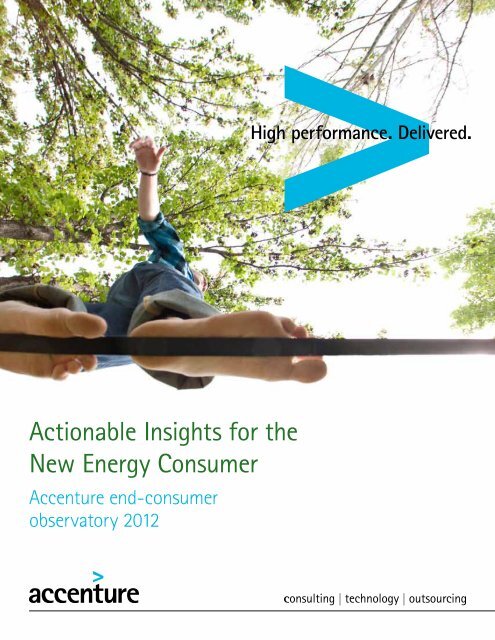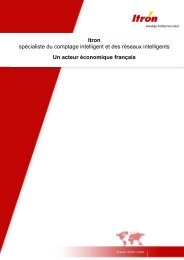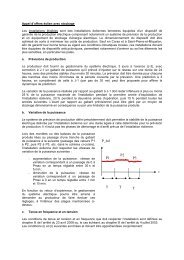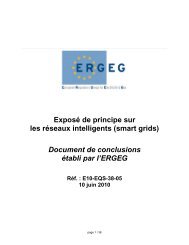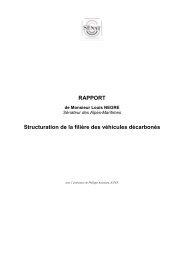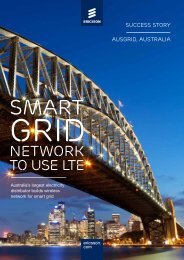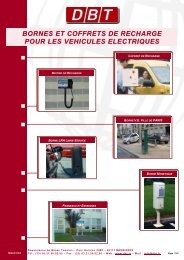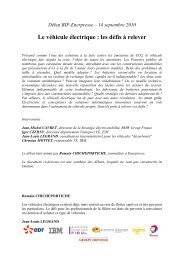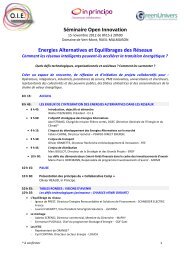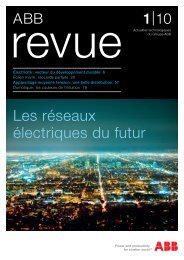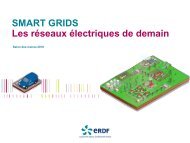Actionable Insights for the New Energy Consumer - Accenture
Actionable Insights for the New Energy Consumer - Accenture
Actionable Insights for the New Energy Consumer - Accenture
- No tags were found...
You also want an ePaper? Increase the reach of your titles
YUMPU automatically turns print PDFs into web optimized ePapers that Google loves.
<strong>Actionable</strong> <strong>Insights</strong> <strong>for</strong> <strong>the</strong><strong>New</strong> <strong>Energy</strong> <strong>Consumer</strong><strong>Accenture</strong> end-consumerobservatory 2012
ContentsForeword 03<strong>Accenture</strong>’s <strong>New</strong> <strong>Energy</strong> <strong>Consumer</strong> research program 04<strong>Consumer</strong> choice 08No. 1 Offer <strong>the</strong> “right” mix of products and services 09No. 2 Maximize consumer willingness to pay 12No. 3 Maximize consumer desire to save 15No. 4 Create a value proposition with bundles 18<strong>Consumer</strong> connection 22No. 5 Optimize <strong>the</strong> value of self-serve 23No. 6 Unlock social media 26<strong>Consumer</strong> loyalty 30No. 7 Manage consumer engagement 31No. 8 Understand churn 36No. 9 Engage <strong>the</strong> next generation 40Implications <strong>for</strong> energy providers 44Appendix: Summary of previous findings from<strong>Accenture</strong>’s <strong>New</strong> <strong>Energy</strong> <strong>Consumer</strong> research program 482
ForewordAround <strong>the</strong> world, energy providers face rapidly evolvingmarketplaces and an environment of continuous change.Concerns over climate change, volatile energy prices andsecurity of supply continue to provide momentum to <strong>the</strong>rollout of disruptive technologies. <strong>Consumer</strong>s are nowcentral to <strong>the</strong>se deployments. At <strong>the</strong> same time, newconsumer opportunities are emerging with <strong>the</strong> increasingadoption of smart technology, mobile devices and <strong>the</strong>integration of web-enabled plat<strong>for</strong>ms, such as socialmedia. The energy landscape is increasingly defined by <strong>the</strong>values and preferences of <strong>the</strong> new energy consumer.More than ever, consumers are seekingadded value, personal connection andproducts and services that align with<strong>the</strong>ir lifestyles—all of which go beyond<strong>the</strong> traditional energy experience. Even ashome automation, energy managementand digital consumer technologiesare enabling a new marketplace <strong>for</strong>energy providers, nontraditionalplayers are quickly emerging anddeveloping new value propositions <strong>for</strong>consumers. Current global economicconditions have also placed a renewedfocus on <strong>the</strong> bottom line <strong>for</strong> bothconsumers and energy providers.Within this environment, energy providersneed to move quickly to define and delivervalue in traditional energy markets and in<strong>the</strong> “beyond-<strong>the</strong>-meter” market. Providersneed to carefully address a broad set ofstrategic and operational imperatives,including:• How do providers adapt to <strong>the</strong>constantly changing needs of consumersand anticipate <strong>the</strong> needs of <strong>the</strong> future?• How do providers effectively balanceand embed consumer preferences into<strong>the</strong>ir operations and product offeringswhile maintaining <strong>the</strong> lowest possiblecost-to-serve?• What traditional capabilities need tochange? What new capabilities need to beaddressed?Standing still is not an option. And yet,more than ever, energy providers facea difficult balancing act of managingoperational realities while creating andcapturing value in <strong>the</strong> evolving energymarketplace. <strong>Accenture</strong>’s <strong>New</strong> <strong>Energy</strong><strong>Consumer</strong> research program and ourexperience working with providers around<strong>the</strong> world have shown that a numberof market and consumer trends haveemerged. Previous <strong>Accenture</strong> studieshave revealed findings around how toengage, educate and create value withsmart technologies and in <strong>the</strong> beyond<strong>the</strong>-metermarket. To help understand<strong>the</strong> new energy consumer landscapeand study <strong>the</strong> specific operationalsteps required <strong>for</strong> energy providersto achieve high per<strong>for</strong>mance todayand in <strong>the</strong> future, <strong>Accenture</strong> presentsour latest research in this report.The companion reference guide to ourresearch, The <strong>New</strong> <strong>Energy</strong> <strong>Consumer</strong>:Balancing Strategic and OperationalImperatives, provides global perspectiveson <strong>the</strong> critical areas of focus, emergingbusiness models, and actionable steps <strong>for</strong>energy providers to prepare <strong>the</strong>ir retailbusiness or customer operations <strong>for</strong> <strong>the</strong>next decade. For more in<strong>for</strong>mation, seepage 47.“The energy consumer landscapeis constantly shifting with smarttechnologies, new products andservices and challenging economicrealities. Developing long-termstrategies and practical next stepsis a complex endeavor. Successrequires a balanced and targetedapproach to identify and delivervalue at scale.”Greg Guthridge, global managing director<strong>Accenture</strong> Retail and Business Services<strong>for</strong> Utilities3
<strong>Accenture</strong>’s <strong>New</strong> <strong>Energy</strong> <strong>Consumer</strong>research programTo help energy providers successfullymeet <strong>the</strong> challenges and opportunitiespresented by <strong>the</strong> evolving energymarketplace, <strong>Accenture</strong> launched amultiyear global research program aimedat gaining a deeper understanding ofconsumers’ attitudes, opinions andpreferences toward energy efficiency,energy management and value-addedproducts and services.Understanding <strong>Consumer</strong>Preferences in <strong>Energy</strong> EfficiencyCompleted in 2010, phase one of <strong>the</strong>program, Understanding <strong>Consumer</strong>Preferences in <strong>Energy</strong> Efficiency, was aglobal consumer survey that producedvaluable insights into consumer behaviors,preferences and attitudes towardenergy efficiency, awareness, readinessand willingness to take action. Thefindings provide a view of consumers’understanding of energy and <strong>the</strong>irrelationship with providers.Revealing <strong>the</strong> Values of <strong>the</strong> <strong>New</strong><strong>Energy</strong> <strong>Consumer</strong><strong>Accenture</strong> built upon those insightswith phase two of <strong>the</strong> program—2011’sRevealing <strong>the</strong> Values of <strong>the</strong> <strong>New</strong> <strong>Energy</strong><strong>Consumer</strong>. This worldwide end-consumersurvey explored consumer preferences,opinions and priorities related tobeyond-<strong>the</strong>-meter products and servicesoffered by utilities or o<strong>the</strong>r emergingproviders. With clear signals in <strong>the</strong>energy marketplace that new businessmodels and nontraditional competitorswere emerging, <strong>the</strong> findings explored <strong>the</strong>possible scope of <strong>the</strong> energy ecosystemand provided insights on <strong>the</strong> consumerpreferences shaping opportunities todayand in <strong>the</strong> future.<strong>Actionable</strong> <strong>Insights</strong> <strong>for</strong> <strong>the</strong> <strong>New</strong><strong>Energy</strong> <strong>Consumer</strong>With a firm view of <strong>the</strong> consumervalues and preferences related toenergy efficiency, beyond-<strong>the</strong>-meterproducts and services and emerging newcompetitors, in 2012, we embarked on <strong>the</strong>third phase of <strong>the</strong> program. Phase threefocuses on developing actionable insightsand tactical implications <strong>for</strong> providers.Recognizing that smart technologyrepresents just one of <strong>the</strong> trendscreating opportunities and challenges <strong>for</strong>providers, <strong>Accenture</strong>’s latest consumerinsights take a multidimensional approachto exploring consumer preferences andbehaviors that define <strong>the</strong> operationalconsiderations <strong>for</strong> addressing <strong>the</strong> newenergy consumer. <strong>Actionable</strong> <strong>Insights</strong><strong>for</strong> <strong>the</strong> <strong>New</strong> <strong>Energy</strong> <strong>Consumer</strong> exploresquestions such as:• What energy and nonenergy-relatedproducts and services are consumersinterested in receiving from <strong>the</strong>irproviders?• How do consumers want to interactwith providers and what expectations are<strong>the</strong>re <strong>for</strong> self-service, social media ando<strong>the</strong>r nontraditional channels?• What opportunities exist to betterbalance cost-to-serve with consumerexpectations?• How can utilities differentiate<strong>the</strong>mselves to more effectively acquireand retain consumers or increaseparticipation in specific programs?• What are <strong>the</strong> preferences and behaviorsof <strong>the</strong> next generation of energyconsumers?Recognizing that energy providers want totake strategic and operational steps today,<strong>the</strong> findings are provided in <strong>the</strong> contextof a consumer’s energy experienceand specifically explore <strong>the</strong> consumerelements of:• Choice. As consumer values related toenergy change, so are <strong>the</strong> options andvalue propositions <strong>the</strong>y want.• Connection. Changes in technology and<strong>the</strong> continued consumer move to onlinechannels are shifting <strong>the</strong> traditionalpreferences <strong>for</strong> interactions.• Loyalty. Engaging consumers andunderstanding <strong>the</strong> drivers of loyaltyand satisfaction are critical to ongoingsuccess.For an overview of <strong>the</strong> key findings fromour previous end-consumer research,Understanding <strong>Consumer</strong> Preferences in<strong>Energy</strong> Efficiency and Revealing <strong>the</strong> Valuesof <strong>the</strong> <strong>New</strong> <strong>Energy</strong> <strong>Consumer</strong>, please seepage 48.4
Methodology and sample<strong>Accenture</strong>’s third global survey isbased on questionnaire-led interviewswith 10,158 residential end consumersin 19 countries, conducted online innative languages in December 2011 <strong>for</strong><strong>Accenture</strong> by Harris Interactive.The selected countries represent a rangeof regulated and deregulated markets.For countries with large and/or diversepopulations, participants were selectedfrom a broad spectrum of locations.The survey explored consumer valuesrelated to electricity, additional energyand nonenergy-related products, andservice perceptions related to <strong>the</strong>irelectricity providers. The survey includedattitudinal, behavioral and demographicquestions. The survey also presentedchoice-based questions about variouscombinations of five key elements ofenergy product and service packages.The in<strong>for</strong>mation was evaluated usinga conjoint analysis to understand howconsumers weigh each component of apackage in <strong>the</strong>ir adoption decision andto identify consumer preferences amongdifferent options.In total, across three years of research,nearly 30,000 consumers have beensurveyed worldwide. The survey samplewas statistically representative of <strong>the</strong>general population in each country,with <strong>the</strong> exceptions of Brazil, China andSouth Africa, where <strong>the</strong> sample wasrepresentative of <strong>the</strong> urban populations.Countries included in <strong>the</strong> multiyear research program, with number of participantsCountry 2012 research 2011 research 2010 researchAustralia 500 500 500Belgium 500 512 -Brazil 500 510 518Canada 500 500 500China 500 502 500Denmark 514 505 500France 500 514 500Germany 500 500 513Italy 500 548 527Japan 500 530 530Ne<strong>the</strong>rlands 500 544 500Norway 500 - -Singapore 505 510 501South Africa 512 500 500South Korea 500 537 500Spain 500 550 500Sweden 500 511 514United Kingdom 627 724 500United States 1,000 1,202 1,005Total individuals surveyed 10,158 10,199 9,1085
<strong>Actionable</strong> insights overviewCustomer choice<strong>Consumer</strong>s will opt <strong>for</strong> products and services that align with<strong>the</strong>ir evolving values.No. 1: Offer <strong>the</strong> "right" mix of products and services.<strong>Consumer</strong>s are increasingly interested in receivingadditional energy and nonenergy-related productsand services from electricity providers.No. 2: Maximize consumer willingness to pay.When it comes to paying a premium,consumers are more attracted todifferentiated products than services.No. 3: Maximize consumer desire to save.The majority of consumers would <strong>for</strong>gocustomer service in return <strong>for</strong> price discounts.No. 4: Create a value proposition with bundles.<strong>Consumer</strong>s are interested in bundled packages thatbetter suit <strong>the</strong>ir lifestyles and needs, particularly when<strong>the</strong>y deliver savings, convenience or ease of use.Customer connectionChanges in technology and <strong>the</strong> continued consumer move onlineare shifting <strong>the</strong> traditional preferences <strong>for</strong> interactions.No. 5: Optimize <strong>the</strong> value of self-serve.Low-touch channels and self-service havereached a tipping point where consumersprefer <strong>the</strong>se options <strong>for</strong> most transactionalinteractions.No. 6: Unlock social media.<strong>Consumer</strong>s in many geographies are interested inengaging with <strong>the</strong>ir electricity providers throughsocial media, in particular, <strong>for</strong> service convenience.Customer loyaltyEngaging consumers and understanding <strong>the</strong> drivers ofloyalty and satisfaction are critical to ongoing success.No. 7: Manage consumer engagement.Satisfaction and engagement actually decreasebased on <strong>the</strong> length of time consumers interactwith <strong>the</strong>ir providers.No. 8: Understand churn.In competitive markets, while switching decisionsare largely price driven, loyalty rewards areemerging as an effective motivator <strong>for</strong> consumersto stay with <strong>the</strong>ir current provider.6No. 9: Engage <strong>the</strong> next generation.Younger consumers can offer a paradox: <strong>the</strong>yprefer a complex mix of high-touch interactions,self-service and social media engagement.
Applicability offindings beyondelectricity<strong>Accenture</strong>’s end consumerresearch program has beendesigned to provide insightsthat are applicable to providersacross gas, electricity and water.Some survey questions are askedspecifically within <strong>the</strong> context ofa consumer’s “electricity provider.”This specificity helps simplifyquestions and focus consumerresponses—ultimately providingmore clarity in <strong>the</strong> findings.From our experience working withutilities across different commoditytypes, we understand <strong>the</strong> uniquechallenges of different providers;however, <strong>the</strong> new energy consumeris having an impact not just onelectricity providers but also ongas and water providers. <strong>Insights</strong>related to channel preferences,interest in additional products andservices, acquisition and churncharacteristics and engagementaround conservation are universaland can help to in<strong>for</strong>m consumerstrategies across providers.7
<strong>Consumer</strong> choiceRegardless of market type, convergingtechnologies and innovative rate and serviceoptions are enabling new value propositions.Across industries, consumerism is on <strong>the</strong> risewith ubiquitous connectivity and productpersonalization becoming <strong>the</strong> norm. It is nowcommonplace <strong>for</strong> consumers to shop around<strong>for</strong> <strong>the</strong> best deal and <strong>the</strong> greatest personalrelevance. <strong>Energy</strong> consumers are no different.Today, <strong>the</strong>y are looking <strong>for</strong> a wide array ofproducts and services from <strong>the</strong>ir energyproviders—even some that are not relatedto energy.8
<strong>Actionable</strong> insight No.1Offer <strong>the</strong> “right” mix of products andservices<strong>Consumer</strong>s are increasingly interested in receiving additionalenergy and nonenergy-related products and services fromelectricity providers.<strong>Energy</strong>-related products andservicesSurvey respondents were providedwith a list of energy-related productsand services. We asked consumers toindicate which products and services <strong>the</strong>ycurrently receive from <strong>the</strong>ir electricityprovider. Not surprisingly, <strong>for</strong> consumerswho receive multiple products or services,natural gas and/or water ranks <strong>the</strong> highestat 38 percent (see Figure 1). However,<strong>the</strong> survey results also highlight thatconsumers currently receive a limitednumber of energy-related products andservices from <strong>the</strong>ir electricity provider; infact, 49 percent receive only electricity.Figure 1. Which of <strong>the</strong> following products and services do you currently receivefrom your electricity provider?Natural gas and/or waterInstallation and/or maintenance services <strong>for</strong> homeenergy devices (e.g., <strong>the</strong>rmostat, furnace, water heater,air conditioner, major home appliances, solar panels)Products and materials to make simple improvements toyour home in order to save electricity (e.g., wea<strong>the</strong>rstripping, compact fluorescent light bulbs)Home energy audits/consultations to identifyopportunities to save electricityMulti-response9%13%13%38%Warranty and/or financing plans <strong>for</strong> home energydevices (e.g., furnace, water heater, air conditioner,major home appliances, solar panels)Devices or services to automate home energy managementbased on your preferences (e.g., remotely control andautomate lighting, heat in your home and some homeappliances)Home energy generation products (e.g., solar,geo<strong>the</strong>rmal, wind)8%7%5%None of <strong>the</strong> above49%Base: All respondents.9
When asked what additional productsand services <strong>the</strong>y may be interestedin signing up to receive from <strong>the</strong>irelectricity provider, consumers currentlynot receiving additional products andservices from <strong>the</strong>ir electricity providerexpress significant interest in a rangeof offers. In Figure 2, 57 percent ofconsumers cite interest in products andmaterials to make simple improvementsto <strong>the</strong>ir homes to save electricity (suchas wea<strong>the</strong>r stripping and compactfluorescent light bulbs) and home energygeneration products (such as solar orwind). In addition to <strong>the</strong>se products, 55percent of consumers are interested inhome energy audits and consultationsto identify areas to save electricity.<strong>Consumer</strong>s also indicate an appetite<strong>for</strong> signing up <strong>for</strong> customized homeenergy management devices or servicesfrom <strong>the</strong>ir electricity providers. Fiftytwopercent are interested in receivinga device or service to automate homeenergy management with featuressuch as <strong>the</strong> ability to remotelycontrol and automate lighting, heatand home appliances. <strong>Consumer</strong>salso express interest in additionalinstallation or financing services, with47 percent interested in installationor maintenance <strong>for</strong> devices such asfurnaces, water heaters and solarpanels, and 46 percent are interestedin warranty and financing plans.Figure 2. How interested are you in signing up <strong>for</strong> <strong>the</strong> following products and services if <strong>the</strong>y were offered by yourelectricity provider?Products and services currently received from electricity providerProducts and materials to make simple improvements to yourhome in order to save electricity (e.g., wea<strong>the</strong>r stripping,compact fluorescent light bulbs)Interest in products and services providedby electricity providers (very/somewhatinterested)13% 57%Home energy generation products(e.g., solar, geo<strong>the</strong>rmal, wind)5%57%Home energy audits/consultations to identify opportunities tosave electricity9%55%Devices or services to automate home energy management basedon your preferences (e.g., remotely control and automate lighting,heat in your home and some home appliances)Installation and/or maintenance services <strong>for</strong> home energydevices (e.g., <strong>the</strong>rmostat, furnace, water heater, air conditioner,major home appliances, solar panels)Warranty and/or financing plans <strong>for</strong> home energy devices(e.g., furnace, water heater, air conditioner, major homeappliances, solar panels)7%8%13%47%46%52%Natural gas and/or water 38%25%Base: All respondents.Base: <strong>Consumer</strong>s who do not currently receive <strong>the</strong> specificproduct and service from <strong>the</strong>ir electricity provider.10
Nonenergy-related services<strong>Consumer</strong> interest in receivingadditional products and services from<strong>the</strong>ir electricity providers extends tononenergy-related services. Figure 3illustrates that 52 percent of consumersare somewhat or very interested inreceiving home repair services such as aplumber. And 49 percent are interested intelecommunications services.Interest also extends to o<strong>the</strong>r consumerlifestyle services. Forty percent areinterested in receiving home servicessuch as security or video monitoring.<strong>Consumer</strong> satisfactionA closer analysis of <strong>the</strong> number ofproducts and services consumers currentlyreceive from <strong>the</strong>ir providers versusconsumer satisfaction shows a trendwhereby satisfaction is correlated with<strong>the</strong> number of products/services received(see Figure 4). <strong>Consumer</strong>s who receiveone to three products/services from <strong>the</strong>irelectricity provider report a satisfactionlevel of 67 percent, but satisfaction rateincreases to 71 percent when lookingat consumers who receive four to sevenproducts/services from <strong>the</strong>ir providers.Figure 3. In addition to energy-related products and services, how interestedwould you be in receiving <strong>the</strong> following from your electricity provider?Home repair services(e.g., plumber)Telecommunications services(e.g., television, Internet, phone, mobile)Home services(e.g., home security, video monitoring in your home)Insurance services(e.g., home, auto, life)Banking services(e.g., bank account, credit card, mortgage)Somewhat interestedBase: All respondents.Very interested29%27%22%36%11% 33%19% 10% 29%20% 49%13% 40%16% 52%Figure 4. <strong>Consumer</strong> satisfaction versus number of products/services received from<strong>the</strong>ir current electricity provider.%80<strong>Consumer</strong> satisfaction75<strong>Consumer</strong> satisfaction706566%67%71%60No products/servicesN= 49491-3 products/servicesN= 46624-7 products/servicesN= 548Number of products/services received from current electricity providerSatisfactionBase: All respondents; N = number of respondents.11
<strong>Actionable</strong> insight No. 2Maximize consumer willingness to payWhen it comes to paying a premium, consumers are moreattracted to differentiated products than services.Premium electricity service“Premium electricity service” conjuresup a number of expectations fromconsumers. When considering what <strong>the</strong>ywould expect from a premium service,we found that 54 percent of consumersexpect personalized energy reports andtools that would help <strong>the</strong>m understandand manage <strong>the</strong>ir electricity usage (suchas electricity used per appliance), and 53percent expect a greater mix of renewableenergy sources (see Figure 5).Figure 5. Which of <strong>the</strong> following products/services would you expect a “premiumelectricity service” to include?Mentioned in top threePersonalized energy reports and tools that help meto understand and manage my electricity usage(e.g., electricity used per appliance)Greater mix of renewable energy sources(e.g., wind, solar, etc.)Availability of home energy generation products(e.g., solar, geo<strong>the</strong>rmal, wind)41%54%53%When directly asked whe<strong>the</strong>r or not <strong>the</strong>ywould be willing to pay a premium <strong>for</strong><strong>the</strong>se additional products/services, onethirdof consumers report that <strong>the</strong>y wouldbe willing to pay more to receive such apremium electricity service (see Figure 6).Improved service priority(e.g., shorter wait times when calling yourelectricity provider)Multiple billing and payment options(e.g., choice of billing dates, ability to pay bycredit card, etc.)Availability of additional programs and technologies(e.g., home automation service, home energy audit,annual heating/cooling maintenance plan, etc.)Access to a personal energy advisor (e.g., personaladvice on decreasing costs, seasonal maintenancereminders, proactive contact when bill increases)36%35%32%29%Base: All respondents.Figure 6. Would you be willing to pay a premium <strong>for</strong> your electricity in order toreceive <strong>the</strong>se additional products/services?Yes, certainlyYes, probably5%26%31% of consumerswould be willing topay a premium toreceive <strong>the</strong>seadditionalproducts/servicesNo, probably not43%No, certainly not26%Base: All respondents.12
Around <strong>the</strong> world, though, we foundthat consumer willingness to pay moreto receive a premium electricity servicevaries. <strong>Consumer</strong>s in emerging countriessuch as Brazil, China, South Africa andSouth Korea are most willing, with 50percent or more of consumers reporting<strong>the</strong>y are “certainly” or “probably”willing to pay a premium. That resultis significantly above <strong>the</strong> average anda marked contrast to consumers inSweden, Belgium and <strong>the</strong> Ne<strong>the</strong>rlands,which trail <strong>the</strong> pack in <strong>the</strong>ir willingnessto pay <strong>for</strong> a premium electricity serviceat 17 percent each (see Figure 7).Figure 7. Would you be willing to pay a premium <strong>for</strong> your electricity in order toreceive <strong>the</strong>se additional products/services?ChinaBrazilSouth AfricaSouth KoreaSingaporeDenmark49% 20%43% 18%47% 11%46% 5%37% 6%29% 2%Average26% 5%Italy28%1%Australia23% 5%Spain21%4%Canada21% 3%Germany21%2%United States19%3%Japan19% 3%Norway17% 2%United Kingdom16% 3%France17% 1%Sweden15%2%Belgium16% 1%Ne<strong>the</strong>rlands15% 2%Yes, probablyYes, certainlyBase: All respondents.13
Figure 8. Which of <strong>the</strong> following products/services would you expect a “premium electricity service” to include?Would you be willing to pay a premium <strong>for</strong> your electricityin order to receive <strong>the</strong>se additional products/services?Greater mix of renewable energy sources72%Yes, certainly/probably31%Improved service priority39%Multiple billing and payment options32%Personalized energy reports and toolsthat help me to understand and managemy electricity usageAvailability of home energy generationproducts31%No, certainly/probably not69%Availability of additional programs andtechnologies18%17%Access to a personal energy advisor14%Base: All respondents.Base: <strong>Consumer</strong>s who say <strong>the</strong>y would "certainly" or "probably" pay a premium <strong>for</strong> electricity in order to receive <strong>the</strong>seadditional products/services.Greener energy mixOn closer inspection, <strong>the</strong> 31 percentof consumers who are “certainly/probably” willing to pay more <strong>for</strong> apremium electricity service have specificexpectations <strong>for</strong> <strong>the</strong> service. Of those whoreport <strong>the</strong>y are willing to pay, 72 percentexpect a “greener energy mix.” This resultpoints to a preference <strong>for</strong> a premiumelectricity service to include a tangibleproduct over improved service options.In fact, <strong>the</strong> issue of “improved servicepriority” ranks as a distant second at 39percent (see Figure 8).<strong>Consumer</strong> preferences <strong>for</strong> a premiumelectricity service, as shown in Figure 8,align closely with <strong>the</strong>ir actual behaviorswhen asked to make trade-offs to create apackage that suits <strong>the</strong>ir needs. When given<strong>the</strong> opportunity to trade off a number ofdefined elements of an energy productand service package, nearly one-thirdof consumers would adopt a premiumgreen package that includes renewableenergy sources, automated electricityconsumption control and <strong>the</strong> best serviceat a 5 percent bill increase (see Figure 9).Figure 9. Premium green package.“Save <strong>the</strong> planet” energy bundleGive me peace of mind with <strong>the</strong> best service and greenoptions (Package adoption ~ up to 29%)Package attributes• Variable electricity price fluctuating based on <strong>the</strong> time of day• Automated consumption control• Full service and support available across multiple channels of interaction• A considerable portion of <strong>the</strong> fuel mix is from renewable energy sources• Personalized energy reports are provided with tips to reduce consumption• Bill increase of 5%Methodology note: Results based on a conjoint analysis.Base: All respondents.14
<strong>Actionable</strong> insight No. 3Maximize consumer desire to saveThe majority of consumers would <strong>for</strong>go customer service inreturn <strong>for</strong> price discounts.<strong>Consumer</strong> savingsSaving money is paramount <strong>for</strong> mostconsumers and <strong>the</strong>ir households—nosurprise <strong>the</strong>re. Having explored consumerinterest in a premium electricity service,we looked to understand <strong>the</strong> o<strong>the</strong>r endof <strong>the</strong> spectrum—discounted electricity.When directly asked, more than threequartersof consumers have some levelof interest in receiving limited customerservice to get a discount on electricityprices (see Figure 10).Figure 10. Would you be interested in receiving discounted electricity prices if itmeant receiving limited customer service?Very interestedSomewhat interested28%48%76% of consumers areinterested in receivinglimited customerservice if it meantreceiving discountedelectricity pricesNot very interestedNot interested at all17%7%Base: All respondents.15
Mirroring interest in a premium electricityservice, consumers in emerging marketsshow <strong>the</strong> most interest in receivinglimited customer service in return <strong>for</strong>discounted electricity prices. In fact,interest in China is just shy of 100percent. As illustrated in Figure 11, mostcountry respondents track fairly close to<strong>the</strong> geographic average of 76 percent,with <strong>the</strong> exception of <strong>the</strong> Ne<strong>the</strong>rlands,where respondents report only 50 percentinterest.Figure 11. Would you be interested in receiving discounted electricity prices if itmeant receiving limited customer service?China 45% 51%South Korea 51% 41%South Africa 43%44%Singapore 52% 33%Brazil 38% 46%Sweden 45% 35%Denmark 45%35%Canada 51% 26%Australia 51% 26%Average 48% 28%Belgium 53%22%Japan 56% 19%Norway 48% 25%Italy 54% 18%United Kingdom 49%24%Spain 47% 23%France 52% 16%United States 46% 21%Germany 46% 17%Ne<strong>the</strong>rlands 39%11%Somewhat interestedVery interestedBase: All respondents.16
Figure 12. Which of <strong>the</strong> following options would you select in order to get discounted electricity prices?Would you be interested in receiving discountedelectricity prices if it meant receiving limitedcustomer service?Mentioned in top threeElectronic billing only (no paper bill) 88%Very/somewhatinterested76%Preauthorized payment plan where bills areautomatically withdrawn from your bankaccountPhone support only available between10:00 – 14:00 Monday to Friday55%68%Online customer support with <strong>the</strong> option ofpay-per-call phone support46%Not very/notinterested at all24%Phone support is provided by representativesoutside of your home countryMinimum 20-minute wait time to speak witha representative on <strong>the</strong> phone20%19%Base: All respondents.Base: <strong>Consumer</strong>s who say <strong>the</strong>y would be "very" or "somewhat" interested in receiving discounted electricityprices if it meant receiving limited customer service.Exploring fur<strong>the</strong>r, we asked consumersto rank <strong>the</strong> limited service options<strong>the</strong>y would select in order to receivediscounted electricity prices. We foundthat consumers would select optionsthat include mandatory electronic billing,automated payments, limited phonesupport and online-only service (seeFigure 12).What are o<strong>the</strong>r ways consumers wouldlike to save money? When we gave <strong>the</strong>m<strong>the</strong> opportunity to trade-off definedelements of an energy package, 70percent of consumers would be willingto adopt a package that combines avariable electricity price with onlineonlycustomer service and a 10 percentdecrease on <strong>the</strong>ir electricity bill (seeFigure 13).The results highlight that consumers’actual behavior, when <strong>for</strong>ced to maketrade-offs between package componentssuch as cost and level of customerservice, closely match reported interest inreceiving discounted electricity.Figure 13. Money-saving package.“Save money” energy bundleGive me <strong>the</strong> lowest possible cost and I’ll do <strong>the</strong> rest(Package adoption ~ up to 70%)Package attributes• Variable electricity price fluctuating based on <strong>the</strong> time of day• Manual actions required to control consumption and costs• Online service only and electronic billing• No renewable energy in fuel mix• Personalized energy reports are provided with tips to reduce consumption• Bill decrease of 10%Methodology note: Results based on a conjoint analysis.Base: All respondents.17
<strong>Actionable</strong> insight No. 4Create a value proposition with bundles<strong>Consumer</strong>s are interested in bundled packages that bettersuit <strong>the</strong>ir lifestyles and needs, particularly when <strong>the</strong>y deliversavings, convenience or ease of use.Product and service bundlesBuilding on <strong>the</strong> insights into whatproducts consumers are interested inreceiving from <strong>the</strong>ir providers, surveyrespondents were provided with ascenario in which electricity providersmay bundle additional products andservices with electricity. The scenarioexplained that, in <strong>the</strong> future, consumersmay be able to purchase a bundle thatincludes electricity as well as o<strong>the</strong>r homeservices (e.g., natural gas and water,home phone and Internet, home security,financial services, home energy audit).We <strong>the</strong>n asked consumers to rank <strong>the</strong> topfactors that would influence <strong>the</strong>ir decisionto sign up <strong>for</strong> such bundles. Consistentwith how consumers have grown used tobundling in o<strong>the</strong>r industries, 89 percentsay receiving a discount is “somewhat”or “very” important. But <strong>for</strong> today’sbusy consumer, convenience and easeof use also emerged as important whenconsidering whe<strong>the</strong>r or not to sign up <strong>for</strong>a bundle, with <strong>the</strong> availability of a singlepoint of contact and a single bill bothranking at more than 70 percent (seeFigure 14).Figure 14. How important would each of <strong>the</strong> following factors be in your decisionto sign-up <strong>for</strong> one of <strong>the</strong>se bundles?In <strong>the</strong> future, electricity providers may bundle additional products and services with electricity. You maybe able to purchase a bundle that includes electricity as well as o<strong>the</strong>r home services (e.g., natural gas andwater, home phone and Internet, home security, financial services, home energy audit, etc.).Gives me a discount 32% 57%89%Provides me with a single point of contact<strong>for</strong> installation, service and issueresolutionAllows me to receive a single bill <strong>for</strong>multiple servicesEnables additional features (e.g., bundlinghome automation and electricity allows meto control my lights and appliances from mymobile phone)Incorporates <strong>the</strong> latest technologies(e.g., a tablet computer or netbook)Somewhat importantBase: All respondents.Very important44% 32% 76%43% 28% 71%36% 19% 55%35% 19% 54%Interestingly, more than half of consumersalso indicate that enabling additionalfeatures (such as home automation) orincorporating <strong>the</strong> latest technologies(such as a tablet computer) would be animportant consideration when signing up<strong>for</strong> a bundle.18
Optimal introduction timeTiming is of <strong>the</strong> essence when introducingbundled products and services. Almosthalf of consumers indicate <strong>the</strong>y wouldbe interested in learning about productand service bundles when <strong>the</strong>ir providerintroduces a new bundled offer or when<strong>the</strong>y are moving into a new home (seeFigure 15). These moments were followedclosely by o<strong>the</strong>r trigger points, such aswhen <strong>the</strong>ir electricity bill is higher thanusual or when a consumer is signing up<strong>for</strong> electricity service. Interestingly, atraditional moment of communicationwith consumers—<strong>the</strong> bill—rankedbehind o<strong>the</strong>r moments, with 36 percentof consumers stating <strong>the</strong>y would beinterested in learning about product andservice bundles when receiving <strong>the</strong>ir bill.To examine <strong>the</strong> interest in learningabout product and service bundles fromano<strong>the</strong>r perspective, we considered <strong>the</strong>influence of age. In some cases, youngerand older consumers stand on opposingsides of when <strong>the</strong> time is right <strong>for</strong> <strong>the</strong>mto learn about new bundles. For example,<strong>the</strong> 18- to 24-year-old segment is mostinterested (at 58 percent) when <strong>the</strong>y havea major life event, such as moving into anew home. In contrast, <strong>the</strong> 55+ segmentis most interested (at 58 percent) when<strong>the</strong> electricity provider makes a change byintroducing a new product/service bundle(see Figure 16).Figure 15. When would you be interested in learning about product and servicebundles from your electricity provider?When my electricity provider introduces a newproduct or service bundleWhen I am moving into a new homeWhen my electricity bill is higher than usualWhen I sign up <strong>for</strong> electricity serviceWhen I get my billWhen I sign up <strong>for</strong> ano<strong>the</strong>r home service(e.g., telephone, Internet, insurance, security, etc.)When I am renovating my homeWhen I am purchasing new appliances/householdelectronicsBase: All respondents.Mentioned in top threeFigure 16. When would you be interested in learning about product and servicebundles from your electricity provider?27%25%23%Mentioned in top three36%43%49%48%47%To generate deeper insights into consumerpriorities across a spectrum of variablesrelated to electricity bundles and valuepropositions, we asked consumers totrade off components—namely, electricityrate options, consumption managementoptions, renewable energy options,customer service options and electricityusage reports. Based on <strong>the</strong> optionsselected, <strong>the</strong>re was a correspondingimpact on <strong>the</strong> bill. In <strong>the</strong> exercise,our surveyed consumers ranked <strong>the</strong>irpreferences and traded off elements tocreate energy packages that meet <strong>the</strong>irneeds (see Figure 17). Diverse preferencesemerged and our analysis shows thatinterest in different packages differs bygeography, income, gender, amount oftime available <strong>for</strong> energy managementand o<strong>the</strong>r factors.When my electricity provider introduces a newproduct or service bundleWhen I am moving into a new homeWhen my electricity bill is higher than usualWhen I sign up <strong>for</strong> ano<strong>the</strong>r home service(e.g., telephone, Internet, insurance, security, etc.)18-24 years 25-34 years 35-54 years 55+ yearsBase: All respondents.36%43%54%58%58%56%45%39%47%45%45%49%45%46%43%42%19
Figure 17. <strong>Energy</strong> product and service packages to meet diverse values.“Make it predictable”energy bundleGive me a consistent bill withno-frills servicePackage attributes• Fixed electricity price requiring no actions to manage usageat particular times• Manual actions required to control consumption• Online service only and electronic billing• No renewable energy in fuel mix• Basic consumption history provided• Bill decrease of 5%<strong>Consumer</strong> attributes• Higher adoption by consumers with higher income• Higher adoption by home owners versus renters“Save money”energy bundleGive me <strong>the</strong> lowest possible cost andI’ll do <strong>the</strong> restPackage attributes• Variable electricity price fluctuating based on <strong>the</strong> time of day• Manual actions required to control consumption• Online service only and electronic billing• No renewable energy in fuel mix• Personalized energy reports are provided with tips to reduceconsumption• Bill decrease of 10%<strong>Consumer</strong> attributes• Higher adoption by those who report <strong>the</strong>y have time tomanage electricity consumption• Higher adoption by home owners versus renters“Save time”energy bundleDeliver a set-it-and-<strong>for</strong>get-it solution <strong>for</strong>managing my energyPackage attributes• Variable electricity price fluctuating hourly• Automated consumption control• Full service and support available across multiple channelsof interaction• No renewable energy in fuel mix• Basic consumption history provided• No impact on bill<strong>Consumer</strong> attributes• Higher adoption by males• Higher adoption by consumers age 18-34“Save <strong>the</strong> planet”energy bundleGive me peace of mind with <strong>the</strong> best serviceand green optionsPackage attributes• Variable electricity price fluctuating based on <strong>the</strong> time of day• Automated consumption control• Full service and support available across multiple channels ofinteraction• A considerable portion of <strong>the</strong> fuel mix is from renewableenergy sources• Personalized energy reports are provided with tips to reduceconsumption• Bill increase of 5%<strong>Consumer</strong> attributes• Higher adoption by consumers age 18-24Note: Illustrative energy packages created based on conjoint analysis.20
<strong>Consumer</strong>connectionThe Web, mobility and social media areincreasingly creating a consumer worlddefined by connectivity. For energy providers,engaging consumers is a balancing actbetween managing operational realities andconnecting with consumers—on <strong>the</strong>ir terms.22
<strong>Actionable</strong> insight No. 5Optimize <strong>the</strong> value of self-serveLow-touch channels and self-service have reached a tippingpoint where consumers prefer <strong>the</strong>se options <strong>for</strong> mosttransactional interactions.High-touch versus low-touchThe consumers participating in our studyreport a dramatic move toward low-touchchannels of interaction such as e-mail orweb portal. We asked consumers about<strong>the</strong>ir preferred channels of interaction <strong>for</strong>specific moments across <strong>the</strong> consumerlife cycle. We <strong>the</strong>n grouped channelsthat had direct, immediate interactionwith a representative as “high-touch”and those that did not as “low-touch.”Not surprisingly, when asked about <strong>the</strong>irpreferred method of interaction, <strong>for</strong>routine items such as receiving <strong>the</strong>ir bill,100 percent of respondents prefer lowtouchchannels (see Figure 18). In fact,<strong>for</strong> eight of <strong>the</strong> nine interactions, <strong>the</strong>majority of consumers prefer low-touchchannels. As <strong>the</strong> complexity of serviceissues increases, consumer preference <strong>for</strong>low-touch channels decreases. On <strong>the</strong>o<strong>the</strong>r side of <strong>the</strong> spectrum, <strong>for</strong> resolvingbilling issues, 60 percent of consumersprefer high-touch channels such as inpersonor on <strong>the</strong> phone.Figure 18. Please select your preferred method of interaction with your electricity provider <strong>for</strong> <strong>the</strong> following events.%100100%9084%80706071%70%67%67%61%59%60%50403029%30%33%33%39%41%40%2016%100%0Receive billPay billLearn aboutnew homeenergy servicesLearn aboutnew energypackagesGet outagein<strong>for</strong>mationChange youraddress/moveSwitch to anew electricityprovider*Sign-up <strong>for</strong>new electricitypackages andservicesResolve issues(e.g., billingissues)Low-touch channels (e-mail, portal, social media,mobile applications, paper, SMS)High-touch channels (in-person, telephone,online chat)* Only in deregulated markets.Base: All respondents.23
Looking more closely at consumerinteraction preferences, consumersoverwhelmingly prefer “Web-enabledchannels” (such as web portals, mobileapplications and email) <strong>for</strong> <strong>the</strong> majorityof <strong>the</strong>ir interactions (see Figure 19).For example, 57 percent of surveyrespondents prefer Web-enabled channels<strong>for</strong> changing <strong>the</strong>ir address and 71 percent<strong>for</strong> receiving <strong>the</strong>ir bill.<strong>the</strong> phone. The importance of in-personinteractions was also highlighted in <strong>the</strong>findings from our 2011 survey, Revealing<strong>the</strong> Values of <strong>the</strong> <strong>New</strong> <strong>Energy</strong> <strong>Consumer</strong>.In this survey, when asked how <strong>the</strong>ywould prefer to purchase a SetAndForgetprogram, 63 percent of consumersreported that <strong>the</strong>y would prefer topurchase from a staff member in a storeor at <strong>the</strong>ir home. 1However, in-person and phone interactionwith a representative remain important<strong>for</strong> learning and purchasing experiences.When it comes to learning about newservices, 17 percent of consumers preferin-person channels and 11 percent preferinteraction over <strong>the</strong> phone. Similarly,when signing up <strong>for</strong> new electricitypackages and services, 21 percent preferin-person channels and 17 percent overFigure 19. Please select your preferred method of interaction with your electricity provider <strong>for</strong> <strong>the</strong> following events.Receive bill Pay bill Learn aboutnew homeenergy servicesLearn aboutnew energypackagesGet outagein<strong>for</strong>mationChange youraddress/moveSwitch to a Sign-up <strong>for</strong>new electricity new electricityprovider* packages andservicesResolveissues (e.g.,billingissues)In person (e.g., at yourhome or in a store)7% 17% 17% 7% 15% 21% 10%Over <strong>the</strong>telephone9% 10% 11% 33% 22% 21% 17% 44%Online chat2% 2% 4% 3% 3% 6%Web-enabled channels71% 69% 52% 51% 54% 57% 50% 45% 40%SMS/text message2% 1% 1% 13% 1%Paper mail27% 15% 18% 18% 10% 11% 13%High-touch channelsLow-touch channels*Only in deregulated markets.Base: All respondents.24
Mastering self-serve channelsEncouraging consumers to use self-servechannels and delivering an effectiveexperience are increasingly important.To better understand expectations, weexplored what characteristics are mostimportant <strong>for</strong> consumers when <strong>the</strong>yconsider using self-service. Ninety-onepercent of consumers cite simplicityand ease of use, along with <strong>the</strong> abilityto resolve a request <strong>the</strong> first time, asimportant characteristics (see Figure 20).Fur<strong>the</strong>rmore, 89 percent of consumershighlight <strong>the</strong> importance of havingtechnical support available—whenever<strong>the</strong>y need it.Figure 20. How important are <strong>the</strong> following characteristics when you consider usingself-serve channels to interact with your electricity provider?Resolves my request <strong>the</strong> first time 33% 58%91%Simple and easy to useTechnical support is availablewhenever I need itKeeps my in<strong>for</strong>mation privateand secureProvides tools to understand myusage and get tips to reduce my bill34%28%38%44%60%57%51%41%91%89%88%85%Faster than speaking to a representative43%38%81%More convenient than speakingto a representative43% 33%76%Somewhat importantVery importantBase: All respondents.25
<strong>Actionable</strong> insight No. 6Unlock social media<strong>Consumer</strong>s in many geographies are interested in engagingwith <strong>the</strong>ir electricity providers through social media, inparticular, <strong>for</strong> service convenience.Interacting through social mediaSocial media is not new, but its reach andvariety of uses continues to grow. Whenit comes to energy-related interactions,consumers are increasingly com<strong>for</strong>tableusing social media. More than one-thirdof our survey respondents use, or planto use, social media to discuss energyrelatedissues with o<strong>the</strong>r consumers orgroups (see Figure 21).Figure 21. Have you used or do you plan to use social media to discuss or learnabout energy-related issues or to interact with your electricity provider?Yes, I currently doNo, but I planto in <strong>the</strong> next12 months11%25%36%8%22%8%30% 30%22%<strong>Consumer</strong>s also show interest in passivelyfollowing or actively interacting with<strong>the</strong>ir electricity providers through socialmedia. Thirty percent of consumersinteract (or plan to interact) with <strong>the</strong>irelectricity provider on popular networks,such as Facebook© and Twitter©, postingcomments or writing “tweets.” Thisactivity represents a sharp rise comparedto our 2010 survey, in which only 1percent of consumers opted <strong>for</strong> usingsocial media to get customized advice on<strong>the</strong> best electricity management programs<strong>for</strong> <strong>the</strong>ir own situation. 2No, and I donot plan to64%Discuss or learnabout energy-relatedissues with o<strong>the</strong>rconsumers or groups70%Follow myelectricity provider(e.g., follow onTwitter, “like” onFacebook, etc.)70%Interact with myelectricity provider(e.g., follow onTwitter, “like” onFacebook, etc.)Base: All respondents.26
When it comes to social media, youngerconsumers once again exhibit specificpreferences. Figure 22 illustrates that 50percent of 18- to 24-year-old consumerscurrently use or plan to use social mediato discuss or learn about energy-relatedissues with o<strong>the</strong>r consumers or groups.Figure 22. Have you used or do you plan to use social media to discuss or learnabout energy-related issues or to interact with your electricity provider?Discuss or learn about energy-relatedissues with o<strong>the</strong>r consumers or groups50%45%36%34%22%However, <strong>the</strong> decline in appeal of socialmedia with older generations is not asmarked as one might expect. Even oldergenerations of consumers are “cyberactive.”For example, 22 percent ofconsumers 55 years and older currentlyuse or plan to use social media to discussor learn about energy-related issues.Follow my electricity provider (e.g., followon Twitter, “like” on Facebook, etc.)18-24 years44%18-24 years25-34 years39%25-34 yearsAverage30%Average35-54 years28%35-54 years55+ years15%55+ yearsGlobal use of social mediaFur<strong>the</strong>r analysis on geographic differencesin social media interest shows a splitbetween mature and emerging economies.One-fifth of consumers in emergingeconomies currently use social media todiscuss energy-related issues with o<strong>the</strong>rconsumers or groups (see Figure 23).But almost 50 percent of consumers inemerging economies plan to use it in <strong>the</strong>next 12 months. These percentages aremore than double <strong>the</strong> response rates ofconsumers in mature economies.Interact with my electricity provider (e.g.,comment on Facebook wall, mention onTwitter, etc.)Currently use social media to interact with electricityprovider or plan to in <strong>the</strong> next 12 monthsBase: All respondents.44%18-24 years40%25-34 years30%Average28%35-54 years14%55+ yearsFigure 23. Have you used or do you plan to use social media to discuss or learnabout energy-related issues or to interact with your electricity provider?Discuss or learn about energy-related issues witho<strong>the</strong>r consumers or groupsYes I currently do11%9%21%No, but I plan to in <strong>the</strong> next12 months25%20%47%No, and I do not plan to64%71%32%TotalMatureeconomies*Emergingeconomies**Mature economies include: Australia, Belgium, Canada, Denmark, France, Germany, Italy, Japan, Ne<strong>the</strong>rlands, Norway,Singapore, Spain, Sweden, United Kingdom, United States.*Emerging economies include: Brazil, China, South Korea, South Africa.Base: All respondents.27
Social media as an in<strong>for</strong>mationsourcePossibilities <strong>for</strong> social media continue togrow. To understand consumer interestin using social media as a source ofin<strong>for</strong>mation, we presented consumerswith a hypo<strong>the</strong>tical situation: If electricityprices fluctuate throughout <strong>the</strong> day,how would you prefer to be notified?Figure 24 shows that younger consumersare <strong>the</strong> most interested in being notifiedof changes in electricity prices via socialmedia. The average rate of interest amongall age groups is 13 percent, but <strong>the</strong>18- to 24-year-old group nearly doublesthat rate at 24 percent of consumersexpressing interest in receiving priceupdates via social media.Encouraging social media useAlthough it’s fair to say that connectingconsumers with utility companieswas not <strong>the</strong> original intent of socialnetworking, such connection is oneway that social media has evolved.Many energy providers are activelytrying to engage consumers throughsocial media to extend <strong>the</strong> consumerrelationship or meet o<strong>the</strong>r goals.Social media can take many <strong>for</strong>ms andbe used in many ways. To understandwhat would engage consumersthrough social media, our surveyexplored some specific tactics thatenergy providers might pursue.Interestingly, consumers emphasizethat receiving quick, convenient servicethrough social media is a critical factorin encouraging <strong>the</strong>m to interact with<strong>the</strong>ir electricity providers. In Figure 25,we see that 50 percent of consumerswould be encouraged to use social mediaif <strong>the</strong>y received quick and convenientservice such as responses to complaintsor to find out about power outages.Figure 24. In <strong>the</strong> future, electricity prices may fluctuate throughout <strong>the</strong> day,making it more expensive to use electricity at certain times. If this were <strong>the</strong> case,how would you like to be notified when <strong>the</strong>re is a significant change in <strong>the</strong> price ofelectricity?Social media*18-24 years25-34 yearsAverage35-54 years55+ years* Mentioned in top three.Base: All respondents.Figure 25. Would <strong>the</strong> following options encourage you to interact with yourelectricity provider through social media?Quick and convenient service from yourelectricity provider (e.g., responds to complaints,outage notifications through Facebook/Twitter)Online community managed by your electricityprovider to discuss and learn about energy-relatedproducts, services and tips to reduce your billAccess to exclusive offers from your electricityprovider through social media (e.g., free ticketsto a sporting event)Recognition from your electricity provider <strong>for</strong> yourengagement through social media (e.g., awards <strong>for</strong>contributing energy-saving tips)Fun and entertaining content created by yourelectricity provider (e.g., YouTube videos, Facebookgames, etc.)ProbablyBase: All respondents.Certainly5%11%13%18%32% 18%33% 14%32% 14%29% 13%23% 8%31%24%42%47%46%50%Ano<strong>the</strong>r 47 percent would be encouragedto join <strong>the</strong> conversation if an onlinecommunity was managed to providemore in<strong>for</strong>mation about energy-relatedproducts and tips on how to reduce bills.28
As we illustrated previously, <strong>the</strong> 55-andolderage group shows <strong>the</strong> least interestin using social media. Even so, this lowerturnout should not be interpreted as “nointerest.” Figure 26 shows that <strong>the</strong>re issignificant opportunity to encourageinteraction through social media.Figure 26. Would <strong>the</strong> following options encourage you to interact with yourelectricity provider through social media?Quick and convenient service from your electricityprovider (e.g., responds to complaints, outagenotifications through Facebook/Twitter)34%49%63%59%For example, one-third of consumers 55years or older would be encouraged to usesocial media if it offered a community todiscuss and learn about energy-relatedproducts or tips to reduce <strong>the</strong>ir bill.Looking at younger consumers 18 to 24years old, 64 percent report that <strong>the</strong>ywould be encouraged to interact throughsocial media if electricity providersoffered access to exclusive rewards suchas free tickets to sporting events. Thedifferences across ages highlight thatproviders need a targeted approach <strong>for</strong>different groups of consumers.Online community managed by your electricityprovider to discuss and learn about energy-relatedproducts, services and tips to reduce your billAccess to exclusive offers from your electricityprovider through social media (e.g., free tickets toa sporting event)Recognition from your electricity provider <strong>for</strong> yourengagement through social media (e.g., awards <strong>for</strong>contributing energy-saving tips)Fun and entertaining content created by yourelectricity provider (e.g., YouTube videos, Facebookgames, etc.)15%26%25%59%53%45%33%44%40%49%40%29%64%57%59%51%18-24 years 25-34 years 35-54 years 55+ yearsBase: All respondents who would “certainly” or “probably” be encouraged to interact with <strong>the</strong>ir electricityprovider through social media.29
<strong>Consumer</strong> loyalty<strong>Consumer</strong> satisfaction, engagement and loyaltyare complex and intertwined. Understanding <strong>the</strong>drivers of satisfaction and consumer stickiness isbecoming increasingly important <strong>for</strong> successfulenergy providers.30
<strong>Actionable</strong> insight No. 7Manage consumer engagementSatisfaction and engagement actually decrease based on <strong>the</strong>length of time consumers interact with <strong>the</strong>ir providers.<strong>Consumer</strong> satisfaction<strong>Consumer</strong> satisfaction is a common metricaround <strong>the</strong> world. To understand basiclevels of satisfaction, consumers wereinvited to rate <strong>the</strong>ir satisfaction with <strong>the</strong>ircurrent electricity provider. In Figure 27,we see that consumers in <strong>the</strong> Ne<strong>the</strong>rlandsexhibit <strong>the</strong> highest levels of satisfaction at82 percent, whereas consumers in SouthAfrica and Japan indicate <strong>the</strong> lowest (29percent and 27 percent, respectively). Theaverage <strong>for</strong> all country respondents is asatisfaction score of 59 percent with <strong>the</strong>irelectricity providers.Figure 27. What is your level of satisfaction with your current electricity provider?Ne<strong>the</strong>rlands 61%21%United States 43%29%Canada 43%23%Norway 44%22%United Kingdom 41%24%France43% 22%Germany 43% 21%Australia 42% 20%Denmark 39% 23%Sweden37%24%China46%15%Brazil38%21%Belgium 47%12%Average 41%18%Italy46% 10%Spain41% 9%Singapore39% 8%South Korea 32%7%South Africa23%6%Japan21%6%SatisfiedVery satisfiedBase: All respondents.31
How involved are consumers?To measure <strong>the</strong> engagement of consumersspecifically in deregulated markets, oursurvey asked three pointed questions andinstructed <strong>the</strong> consumers to rate <strong>the</strong>irresponses on a scale from 1 to 10, with10 being <strong>the</strong> highest:• Satisfaction: “What is your level ofsatisfaction with your current electricityprovider?”• Recommendation: “Would yourecommend your current electricityprovider to your family/friends?”• Switching: “Are you consideringswitching to ano<strong>the</strong>r electricity providerin <strong>the</strong> next 12 months?”Figure 28. Engagement score with electricity provider (deregulated markets only).Engagement score 67%Components of <strong>the</strong> engagement scoreSatisfiedLikely to recommendNot likely to switchBase: Respondents in deregulated markets only.Note: The engagement score is <strong>the</strong> average of <strong>the</strong> numeric values of <strong>the</strong> three main components in <strong>the</strong> figure. Theengagement score is <strong>the</strong> percentage of individuals that are considered engaged (e.g., an index of 67 means that 67 outof 100 individuals—or 67 percent—are engaged).68%65%68%To create a holistic view of consumerengagement with <strong>the</strong>ir providers incompetitive markets, we aggregatedresponses to <strong>the</strong>se three questions. Theresulting consumer engagement scorerepresents one of <strong>the</strong> most critical metrics<strong>for</strong> energy providers. Averaging <strong>the</strong> totalresponses, we learned that globally 67percent of consumers are engaged with<strong>the</strong>ir electricity providers (see Figure 28).Figure 29 illustrates that in deregulatedmarkets across geographies, responsesby country do not stray too far from <strong>the</strong>median score of engagement—only a 7percent difference up or down. <strong>Consumer</strong>sin France take top spot as <strong>the</strong> mostengaged (at 74 percent), while SouthKorean consumers are <strong>the</strong> least engaged(at 60 percent).Figure 29. Engagement score with electricity provider.FranceNe<strong>the</strong>rlandsUnited States*Canada*NorwaySwedenUnited KingdomAverage74%72%71%70%69%68%68%67%Denmark66%Australia65%Italy65%Germany65%Belgium64%Spain62%South Korea60%32Engagement score* Includes only deregulated states and/or provinces.Base: Respondents in deregulated markets only.
Extent of consumer interactionIn general, electricity and energyproviders are not necessarily top ofmind <strong>for</strong> consumers; however, manytrends in <strong>the</strong> marketplace today—smartmetering, value-added products andservices, and energy conservation—requiregreater levels of consumer interaction.Respondents spent, on average, 9 minutesinteracting with a representative of <strong>the</strong>irelectricity provider over <strong>the</strong> past 12months (see Figure 30). Highlighting <strong>the</strong>low level of interaction, 54 percent statedthat <strong>the</strong>y have not interacted with <strong>the</strong>irelectricity provider in <strong>the</strong> past 12 months.Figure 30. In <strong>the</strong> past 12 months, how much time did you spend in total interactingwith a representative of your electricity provider (e.g., over <strong>the</strong> phone, e-mail, in astore, in your home, etc.)?I have not interacted with myelectricity provider in <strong>the</strong> past12 monthsLess than 5 minutes5 to 10 minutes10 to 20 minutes9%12%12%54%Average timespent interacting:9 minutes20 to 30 minutes5%30 minutes to one hour4%Greater than one hour4%Base: All respondents.33
Fur<strong>the</strong>r analysis of specific geographiesshows that in <strong>the</strong> emerging economyof South Africa, <strong>the</strong> interaction time ismore than double <strong>the</strong> average (see Figure31). Additionally, it is interesting to notethat a handful of mature economies withderegulated electricity markets, such asBelgium, Australia, Spain and <strong>the</strong> UnitedKingdom, also rank above <strong>the</strong> average.Figure 31. In <strong>the</strong> past 12 months, how much time did you spend in total interactingwith a representative of your electricity provider (e.g., over <strong>the</strong> phone, e-mail, in astore, in your home, etc.)?South Africa 19Brazil 14Belgium 13China 13Australia 12Spain 11United Kingdom 10Average 9Italy 8Denmark 8Ne<strong>the</strong>rlands 8United States 7Norway 7Singapore 7France 7Sweden 7Germany 6Canada 6South Korea 5Japan 3Average time spent in minutesBase: All respondents.34
Taking a closer look, we can see that <strong>the</strong>more time consumers spent interactingwith representatives of <strong>the</strong>ir electricityprovider over <strong>the</strong> past 12 months,<strong>the</strong> more <strong>the</strong>ir levels of satisfactionand engagement seem to decrease. Ifconsumers have interacted with <strong>the</strong>irenergy provider <strong>for</strong> more than one hourin <strong>the</strong> past year, satisfaction drops by 7percent compared to those who have notinteracted at all. The drop in engagementover <strong>the</strong> same range is even moredramatic—falling a full 10 percent (seeFigure 32).Figure 32. <strong>Consumer</strong> satisfaction and consumer engagement versus time spent interacting with a representative of electricityprovider in <strong>the</strong> past 12 months.%100<strong>Consumer</strong> satisfaction%100<strong>Consumer</strong> engagement9595909085858080<strong>Consumer</strong> satisfaction75706560555067%67%68%I have not Less than 5 to 10interacted 5 minutes minutesin <strong>the</strong> past12 months67%10 to 20minutes66%20 to 30minutes64%30 minutesto onehour60%Greaterthan onehour<strong>Consumer</strong> engagement75706560555069%67%66%I have not Less than 5 to 10interacted 5 minutes minutesin <strong>the</strong> past12 months65%10 to 20minutes63%20 to 30minutes63%30 minutesto onehour59%Greaterthan onehourTime spent interacting with a representative of yourelectricity provider in <strong>the</strong> past 12 monthsTime spent interacting with a representative of yourelectricity provider in <strong>the</strong> past 12 monthsSatisfactionBase: All respondents.<strong>Consumer</strong> engagementBase: Respondents in deregulated markets only.35
<strong>Actionable</strong> insight No. 8Understand churnIn competitive markets, while switching decisions are largelyprice driven, loyalty rewards are emerging as an effectivemotivator <strong>for</strong> consumers to stay with <strong>the</strong>ir current provider.Willingness to recommend andswitchIn deregulated utility markets, high ratesof consumer churn can erode revenue andmay be a sign of trouble in <strong>the</strong> business.After measuring consumer satisfactionlevels, we wanted to better understandtwo o<strong>the</strong>r factors that influenceengagement: willingness to recommendand retention.In deregulated markets, 55 percent ofconsumers would recommend <strong>the</strong>irelectricity provider to family and friends(see Figure 33). While 14 percent ofrespondents would not recommend <strong>the</strong>irprovider, 25 percent are consideringswitching to ano<strong>the</strong>r electricity providerin <strong>the</strong> next 12 months.Figure 33. Willingness to recommend and retention.Would you recommend your current electricity providerto your family/friends?Are you considering switching to ano<strong>the</strong>r electricity providerin <strong>the</strong> next 12 months?CertainlyProbably19%36%55% of consumerswould recommend<strong>the</strong>ir electricityproviderCertainly switchProbably switchNeutral11%14%24%25% of consumersare consideringswitching to ano<strong>the</strong>relectricity providerProbably not switch13%Neutral31%Certainly not switch38%Probably not8%Certainly not6%Base: Respondents in deregulated markets only.36
<strong>Consumer</strong> willingness to switch electricityproviders differs across geographies.Notably, consumers in France report <strong>the</strong>lowest intention to switch electricityproviders with a mere 7 percent sayingthat <strong>the</strong>y are considering switching in<strong>the</strong> next 12 months (see Figure 34).Germany and Belgium rise to <strong>the</strong> topwith 19 percent and 16 percent ofconsumers, respectively, reporting that<strong>the</strong>y “certainly” intend to switch providersin <strong>the</strong> next 12 months.The drivers behind churnWhat drives a consumer to end <strong>the</strong>relationship with his or her electricityprovider? Perhaps unsurprisingly, <strong>the</strong>primary factor is that consumers switch<strong>for</strong> savings (see Figure 35). Eighty-ninepercent of consumers in deregulatedmarkets report that a reduced electricitybill is a main factor that motivatesswitching providers.While price is important, it is not <strong>the</strong>only factor consumers consider. Sixtypercent of consumers would be motivatedto switch providers <strong>for</strong> a rate plan thatbetter suits <strong>the</strong>ir needs. Renewable energyoptions are also enticing <strong>for</strong> one-third of<strong>the</strong> survey respondents, as are productand service bundles, loyalty rewards andbetter customer service.Figure 34. Are you considering switching to ano<strong>the</strong>r electricity provider in <strong>the</strong> next12 months?GermanyBelgiumItalyAustraliaUnited KingdomSpainSwedenNe<strong>the</strong>rlandsAverageDenmarkUnited States*NorwaySouth KoreaCanada*FranceProbably switch13%15%Certainly switchBase: Respondents in deregulated markets only.* Includes only deregulated states and/or provinces16% 19%20% 8%16% 11%12% 14%17% 9%14% 11%12% 8%12%9% 9%4% 3%15% 16%13% 12%14%7%4%11%11%Figure 35. What factors would motivate you to switch to a new electricityprovider?Mentioned in top threeReduced electricity bill 89%Rate plans that better suit my needs(e.g., fixed price, reduced price inevenings, etc.)60%Provides renewable energy options(e.g., wind, solar, etc.)Product and service bundles that bettersuit my needs (e.g., bundle natural gas,home phone, Internet, home energy audit,etc.)Better loyalty rewards program33%32%32%Better customer service/support31%Better payment options17%Base: Respondents in deregulated markets only.37
Loyalty rewards programsLoyalty rewards programs have long beena retention tool in many industries. Asa result, consumers have grown usedto being rewarded by <strong>the</strong>ir providers.Our findings show that, indeed, loyaltyprograms are an effective tool tomotivate consumers to stay with <strong>the</strong>ircurrent electricity provider. In deregulatedmarkets, 69 percent of consumers wouldbe motivated to stay if <strong>the</strong>ir currentelectricity provider rewarded <strong>the</strong>m with“points” that can be used to purchase avariety of products and services. O<strong>the</strong>rloyalty constructs such as surpriserecognition programs or rewards pointsthat are only redeemable at specific timesin <strong>the</strong> future do not fall far behind (seeFigure 36).Figure 36. Would <strong>the</strong> following rewards programs motivate you to stay with yourcurrent electricity provider?Yes, greatlyYes, somewhatNo23%46%31%69%Ongoing traditionalloyalty-points programearns points that canbe used to purchase avariety of products andservices20%40%40%Surprise customerrecognition programwhere you receiveunexpected rewardsfrom your electricityprovider60%20%43%37%63%An ongoing rewardsprogram where youaccumulate pointsthat are redeemable ata specific time in <strong>the</strong>futureBase: Respondents in deregulated markets only.Loyalty rewardsA closer look<strong>Energy</strong> providers in competitive markets are increasingly using loyalty rewardprograms as a tool to retain consumers and encourage certain behaviors.<strong>Accenture</strong>’s consumer research has explored loyalty rewards programs from anumber of angles, shedding light on <strong>the</strong> way that consumers perceive rewards.Interestingly, while more than 60 percent of consumers report that loyaltyprograms would encourage <strong>the</strong>m to stay with an existing provider (see Figure36), only 32 percent of consumers say that a better loyalty program wouldbe a reason to switch (see Figure 35). Fur<strong>the</strong>rmore, in Revealing <strong>the</strong> Valuesof <strong>the</strong> <strong>New</strong> <strong>Energy</strong> <strong>Consumer</strong>, consumers reported that after price, loyaltyrewards were <strong>the</strong> most critical element considered when adopting an energymanagement program. 3These results suggest that consumers have differing values toward loyaltyprograms when assessing <strong>the</strong>ir current provider or specific energy programsversus externally assessing ano<strong>the</strong>r provider. When evaluating <strong>the</strong>ir currentprovider and making decisions about adopting an energy management program,loyalty rewards are top of mind. However, when evaluating a different provider,loyalty rewards are less of a differentiator.38
<strong>Consumer</strong> satisfaction, interactionand switchingAs previously stated, <strong>the</strong>re is arelationship between <strong>the</strong> amount oftime consumers spend interacting with<strong>the</strong>ir providers and <strong>the</strong>ir satisfaction.Our survey results show an evenstronger correlation between time spentinteracting and a consumer’s likelihoodto switch providers (see Figure 37). Asconsumers spend more time interactingwith a representative of <strong>the</strong>ir electricityprovider, satisfaction level drops and <strong>the</strong>likelihood of switching providers increasesdramatically. Thirty-eight percent ofconsumers who have not interacted with<strong>the</strong>ir provider in <strong>the</strong> past 12 monthsreport that <strong>the</strong>y are likely to switch;however, this number grows to 55 percent<strong>for</strong> consumers who have spent more thanan hour interacting with <strong>the</strong>ir provider in<strong>the</strong> past 12 months.Figure 37. <strong>Consumer</strong>s’ likelihood to switch electricity provider versus time spent interacting with a representative of <strong>the</strong>electricity provider in <strong>the</strong> past 12 months.%100<strong>Consumer</strong>s’ likelihood to switch and satisfaction90<strong>Consumer</strong>s’ likelihood to switch and satisfaction8070605040302010069%38%I have notinteracted in<strong>the</strong> past 12months68%45%Less than5 minutes69%48%5 to 10minutes68%48%10 to 20minutes67%51%20 to 30minutes65%50%30 minutesto one hour62%55%Greater thanone hourTime spent interacting with a representative of your electricity provider in <strong>the</strong> past 12 monthsSatisfactionBase: Respondents in deregulated markets only.<strong>Consumer</strong>s’ likelihood to switch39
<strong>Actionable</strong> insight No. 9Engage <strong>the</strong> next generationYounger consumers can offer a paradox: <strong>the</strong>y prefer a complexmix of high-touch interactions, self-service and social mediaengagement.Less loyal and more interactiveNearly a third of 18- to 34-year-oldconsumers indicate strong loyalty to<strong>the</strong>ir electricity provider indicating<strong>the</strong>y will “certainly not switch” in <strong>the</strong>next 12 months (see Figure 38). Incomparison, nearly half of consumersaged 55 or older say that <strong>the</strong>y will“certainly not switch” electricityproviders in <strong>the</strong> next 12 months.Interestingly, younger consumers alsospend more time interacting withrepresentatives of <strong>the</strong>ir electricityproviders. <strong>Consumer</strong>s who are 18 to 34years old interact with <strong>the</strong>ir providers 11minutes a year, compared to an averageof nine minutes (see Figure 39). Whilea difference of two minutes may soundsmall, <strong>the</strong> operational cost implications<strong>for</strong> utilities can be significant.Young with diverse channelpreferencesCountering widely held beliefs thatyounger consumers prefer low-touchcontact and self-serve channels, 18- to24-year-old respondents have a strongerpreference <strong>for</strong> high-touch channels <strong>for</strong>specific events, such as in person or on<strong>the</strong> phone, than older consumers. Figure40 illustrates that <strong>the</strong>y prefer to interactwith a customer service representativemore than o<strong>the</strong>r age groups and inparticular to learn about and sign up <strong>for</strong>new electricity packages or in deregulatedmarkets, to switch providers.Figure 38. Are you considering switching to ano<strong>the</strong>r electricity provider in <strong>the</strong> next12 months?Certainly switchProbably switchNeutralProbably not switchCertainly not switch9%17%26%17%Base: Respondents in deregulated markets only.12%31% 32%18-24 years13%16%27%25-34 years11%14%26%12%37%35-54 years9%10%19%13%49%55+ yearsFigure 39. In <strong>the</strong> past 12 months, how much time did you spend in total interactingwith a representative of your electricity provider (e.g., over <strong>the</strong> phone, e-mail, in astore, in your home, etc.)?18-24 years 1125-34 yearsAverage91135-54 years855+ years7Average time spent in minutesBase: All respondents.40
Figure 40. Please select your preferred method of interaction with your electricity provider <strong>for</strong> <strong>the</strong> following events.18-24 years25-34 years35-54 years55+ years43%34%29%22%Learn about new energypackages57%66%71%78%Learn about new homeenergy services42%58%32%68%27%73%20%80%Sign-up <strong>for</strong> new electricitypackages and services56%44%46%54%38%62%34%66%Change your address/move47%37%30%24%53%63%70%76%24%18%14%10%Pay bill76%82%86%90%Resolve issues (e.g., billingissues)38%62%41%59%40%60%43%57%Switch to a new electricityprovider(deregulated markets only)53%47%44%56%37%63%31%69%High-touch channels (in-person, telephone, online chat)Low-touch channels (e-mail, portal, social media, mobile applications, paper, SMS)Base: All respondents.41
In addition, Figure 41 shows that interestin interacting through social media issignificantly higher among youngerconsumers. Thirty-nine percent or moreof 18- to 34-year-old consumers arecurrently using or planning to use socialmedia to discuss or learn about energyrelatedissues with o<strong>the</strong>r consumers orgroups, to follow <strong>the</strong>ir electricity providersor to interact with <strong>the</strong>ir provider.Figure 41. Have you used or do you plan to use social media to discuss or learn about energy-related issues or to interact withyour electricity provider?Discuss or learn aboutenergy-related issues witho<strong>the</strong>r consumers or groupsFollow my electricityprovider (e.g., follow onTwitter, “like” on Facebook,etc.)Interact with my electricityprovider (e.g., comment onFacebook wall, mention onTwitter, etc.)18-24 years50%44%44%25-34 years45%39%40%Average36%30%30%35-54 years34%28%28%55+ years22%15%14%Currently use social media to interact with electricity provider or plan to in <strong>the</strong> next 12 monthsBase: All respondents.42
Implications <strong>for</strong> energyprovidersOur findings illustrate that <strong>the</strong> preferences andvalues of <strong>the</strong> new energy consumer are diversebut offer opportunities to deliver on multipleimperatives—consumer satisfaction, cost reductionand revenue growth. <strong>Energy</strong> providers, regulatedand deregulated alike, will need new capabilities andstrategies in order to develop solutions that redefine<strong>the</strong> value proposition <strong>for</strong> consumers while creatingnew opportunities <strong>for</strong> <strong>the</strong>mselves.44
Create value with consumer choice:Use choice to create targetedpropositions that deliver value to<strong>the</strong> provider and consumer<strong>Consumer</strong> choice has emergedas a powerful tool <strong>for</strong> definingnew value propositions, shapingconsumer expectations and creatingtargeted offerings that alignwith consumer preferences. Theconcept of choice is applicable notonly in deregulated markets.<strong>Consumer</strong>s are interested in receivingadditional energy and nonenergyrelatedproducts and services from<strong>the</strong>ir providers. Seizing this opportunityrequires a move beyond <strong>the</strong> commodity,developing innovative offerings that blend<strong>the</strong> optimal mix of products and services—such as different rate structures, energymanagement technology, renewableenergy sources, and o<strong>the</strong>r energy ornonenergy-related products and services.Bundling energy and value-addedproducts or services can also be aplat<strong>for</strong>m to personalize <strong>the</strong> energyexperience, helping develop uniqueand targeted value propositions <strong>for</strong>specific groups of consumers whileaddressing providers’ cost, revenueand satisfaction objectives. For manyproviders, implementing bundling willlikely require a significant shift in termsof <strong>the</strong> people, process and technologycapabilities required to create, scale andmanage a portfolio of bundled productsand services.Establishing differentiated premium ordiscounted offerings can help energyproviders deliver on diverse consumerexpectations, manage cost-to-serveand ultimately create a more compellingenergy offering <strong>for</strong> consumers. To pinpointopportunities, providers must identify<strong>the</strong> cost and consumer satisfactionlevers across channels with a focus onrationalizing service with little to noimpact on consumer satisfaction. In short,providers will need to excel at innovation,whe<strong>the</strong>r it is in product development,bundling or consumer messaging.Redefine consumer connection:Develop a multifaceted consumerrelationship that delivers low-costself-service <strong>for</strong> <strong>the</strong> majority oftransactions and high-value service<strong>for</strong> critical interactions<strong>Energy</strong> providers have an opportunityto reinvent <strong>the</strong>ir approach to customerservice by creating an interaction mixthat reduces operational costs anddelivers what consumers want.To succeed at developing multifacetedrelationships, providers will need to buildeffective self-serve capabilities and <strong>the</strong>nwork to drive consumer adoption <strong>for</strong>certain transactions. At <strong>the</strong> same time,interactions with provider representativesmust become value added, resolvingissues and delivering targeted treatmentsthat create positive experiences.Social media has entered <strong>the</strong> mainstreamas a distinct channel of interaction<strong>for</strong> utilities. It is no longer enough <strong>for</strong>providers to simply monitor consumersentiment through social media. Ra<strong>the</strong>r,energy providers need to have a socialmedia presence and use it holistically tobetter understand <strong>the</strong> consumers who useit and interact with those interested inbeing engaged through social media.As providers develop this multifacetedrelationship with consumers, <strong>the</strong>y willneed to seamlessly accommodate awide array of consumer channels andalign messaging under a single point ofaccountability within <strong>the</strong> organization.Engage to build consumer loyalty:Develop operational and consumerinsights to engage consumers andbuild loyaltyIt is becoming clear that <strong>for</strong> energyproviders, data analysis and <strong>the</strong>ability to drive insights through toaction are critical competencies.Providers need to develop analyticscapabilities and processes to learnfrom consumers, understand <strong>the</strong>preferences of different segmentsand implement targeted experiencesthat cost-effectively build loyalty andcreate new revenue opportunities.<strong>Consumer</strong>s have limited interactionswith <strong>the</strong>ir energy providers. The moreinteractions <strong>the</strong>y have, <strong>the</strong> less satisfied<strong>the</strong>y are, and in deregulated markets,<strong>the</strong> more likely <strong>the</strong>y are to churn. Thesefindings suggest that <strong>the</strong> majority ofcurrent interactions are neutral ornegative. Providers have an opportunity todevelop operational and consumer insightsto identify <strong>the</strong> root cause of contacts and<strong>the</strong>n manage <strong>the</strong>m to support positiveoutcomes. This requires analysis andcontinuous improvement capabilitiesthat apply equally to developingconsumer and operational insights.In addition, younger consumers interactmore with <strong>the</strong>ir energy providers, areless loyal and have differing channelpreferences, all of which increase servicecost and complexity. To effectivelyengage different groups of consumers,energy providers must develop targetedapproaches that balance cost-to-servewith consumer preferences.45
Conclusion<strong>Consumer</strong> values and preferences arechanging as <strong>the</strong> energy marketplaceevolves. Providers have an opportunityto harness <strong>the</strong>se changes to create value,engage consumers and build loyalty.To develop <strong>the</strong> competencies critical<strong>for</strong> <strong>the</strong> future, providers may choose todevelop an ecosystem of partnershipsand collaboration that extends <strong>the</strong>consumer relationship and createsagility and scalability <strong>for</strong> new productsor services. These partnerships mayinclude operational outsourcing to allowproviders to focus on core strengths, ormay extend to <strong>the</strong> broader community ofo<strong>the</strong>r retailers, academia, governments,cities and o<strong>the</strong>r stakeholders.As <strong>the</strong> energy marketplace continuesto evolve and providers assess <strong>the</strong>irapproach to markets and consumers,dynamic new business models areemerging. Some providers are movingto capture value beyond <strong>the</strong> meterwhile o<strong>the</strong>rs are developing roles astrusted energy advisors. Regardless of<strong>the</strong> business model (or combination ofmodels) a provider selects, <strong>the</strong>re is alsoa need to trans<strong>for</strong>m traditional utilityoperating models to create organizationsthat are more consumer focused, agileand cost effective.The most successful energy providers willbe those that deeply understand consumerbehaviors, attitudes and preferences andtake a balanced and targeted approachto identify and deliver value at scale.46
Learn about The <strong>New</strong><strong>Energy</strong> <strong>Consumer</strong>:Balancing Strategicand OperationalImperatives<strong>Accenture</strong> believes that as newtechnologies, consumer trendsand regulatory changes intensify,energy providers face a dynamicenergy marketplace that presentsa host of new opportunities andchallenges. The range of possibilitiesand areas <strong>for</strong> focus are vast andwill differ <strong>for</strong> each provider. Withthis in mind, we have developed acompanion reference guide, The <strong>New</strong><strong>Energy</strong> <strong>Consumer</strong>: Balancing Strategicand Operational Imperatives.The guide contains perspectives andglobal insights based not only on<strong>Accenture</strong>’s end-consumer researchprogram, but also on a wide variety ofo<strong>the</strong>r industry research, interviews withclients and industry experts, crossindustryexperiences and <strong>Accenture</strong>’sown knowledge of managing utilityoperations. It covers areas such as:• The macro trends creating <strong>the</strong>evolving energy marketplace inboth regulated and deregulatedenvironments.• The critical focus areas utilitiesmust consider <strong>for</strong> <strong>the</strong> evolvingenergy marketplace: <strong>the</strong> need <strong>for</strong>innovation, shifts in <strong>the</strong> consumerutilityrelationship, <strong>the</strong> challenges andopportunities of increased data and <strong>the</strong>need <strong>for</strong> collaboration.• The strategic business model optionsavailable to utilities to navigate <strong>the</strong>disruptive changes in <strong>the</strong> industry.• Immediate actions utilities cantake to balance current challengeswhile creating a foundation to takeadvantage of <strong>the</strong> opportunities of <strong>the</strong>future.• The key capabilities that willdetermine success as providers selecta path <strong>for</strong>ward in <strong>the</strong> evolving energymarketplace.47
Appendix: Summary ofprevious findings from<strong>Accenture</strong>’s <strong>New</strong> <strong>Energy</strong><strong>Consumer</strong> research program48
In previous years, <strong>Accenture</strong>’s endconsumerresearch focused onunderstanding consumer preferences andrevealing attitudes and behaviors that arechanging <strong>the</strong>ir relationship with energyproviders. Following is an overview of<strong>the</strong> key findings from our previous endconsumerstudies.Understanding <strong>Consumer</strong>Preferences in <strong>Energy</strong> EfficiencyIn 2010, <strong>Accenture</strong> developed <strong>the</strong> firstend-consumer study, Understanding<strong>Consumer</strong> Preferences in <strong>Energy</strong>Efficiency, to investigate consumerattitudes and behaviors toward electricitymanagement programs. The research setout to understand consumer opinionsand preferences toward electricitymanagement programs by answering sixcore questions:1. Do consumers have a clearunderstanding of <strong>the</strong> impact of electricityconsumption on <strong>the</strong> environment?2. Do <strong>the</strong>y understand how <strong>the</strong>y canoptimize <strong>the</strong>ir electricity consumption?3. Do <strong>the</strong>y feel social pressure to do so?4. Which organizations do <strong>the</strong>y trust toin<strong>for</strong>m <strong>the</strong>m about actions <strong>the</strong>y can taketo optimize <strong>the</strong>ir electricity consumption?5. Are <strong>the</strong>y aware of electricitymanagement programs?6. What are <strong>the</strong> drivers and barriers toadoption of electricity managementprograms?The online survey, which involved morethan 9,000 individuals in 17 geographies,provided insights into <strong>the</strong> emerging trendsin new energy consumerism:• There is a significant contradictionbetween consumer perceptions and <strong>the</strong>iractual knowledge of energy efficiency.• <strong>Consumer</strong>s’ first instinct is to contact<strong>the</strong>ir utilities/electricity providers <strong>for</strong>energy-efficiency activities; however,providers still need to build trust andcredibility.• While price remains a key factor toadoption, <strong>the</strong> extent of <strong>the</strong> utilities’/electricity providers’ control over energyuse has emerged as a potential barrier.• Channels and contact points <strong>for</strong>utilities/electricity providers tocommunicate with consumers are diverse.• Adoption of electricity managementprograms is influenced by fragmented andnontraditional consumer preferences.The findings illustrated that consumerbehaviors <strong>for</strong> energy-efficiencysolutions are highly complex withbroad diversity in perceptions, attitudesand preferences. For providers, <strong>the</strong>traditional customer service model hashistorically focused on cost and riskpriorities. It was clear from <strong>the</strong> findingsthat <strong>the</strong>se priorities and capabilitieswould not provide adequate supportto new broad-based programs aroundmass-market energy efficiency andconservation. Thus, providers, regulatedand deregulated alike, face <strong>the</strong> need <strong>for</strong>new consumer-centric competenciesand differentiated energy efficiency andconservation programs to attract andengage a diverse consumer market.Revealing <strong>the</strong> Values of <strong>the</strong> <strong>New</strong><strong>Energy</strong> <strong>Consumer</strong>In 2011, <strong>Accenture</strong> embarked on phasetwo of <strong>the</strong> end-consumer researchprogram—Revealing <strong>the</strong> Values of <strong>the</strong> <strong>New</strong><strong>Energy</strong> <strong>Consumer</strong>. Building on <strong>the</strong> findingsfrom Understanding <strong>Consumer</strong> Preferencesin <strong>Energy</strong> Efficiency, we recognizedthat <strong>the</strong> energy ecosystem is quicklyevolving. Smart technologies are enablinga marketplace <strong>for</strong> in-home consumertechnologies, demand-side managementprograms and related support services.However, proliferation in <strong>the</strong> beyond-<strong>the</strong>metermarket also creates new pressuresfrom nontraditional players.To dig deeper into <strong>the</strong> emerging energymarketplace, <strong>the</strong> worldwide endconsumersurvey included more than10,000 respondents and exploredconsumer preferences, opinions andpriorities related to beyond-<strong>the</strong>-meterproducts and services offered by utilitiesor o<strong>the</strong>r emerging providers. Through <strong>the</strong>research, <strong>Accenture</strong> set out to investigate:1. What are <strong>the</strong> energy consumer’straditional and nontraditional valuessurrounding in-home technologies,electricity management programs, andrelated products and services?2. How much value do consumers placeon smart home technologies, mobileapplications and nontraditional channels?3. How can providers differentiateelectricity management programs?4. Do consumers value electricitymanagement programs that areconvenience focused?5. Are consumers interested in <strong>the</strong>delivery of energy management programsthrough third parties?49
The findings from Revealing <strong>the</strong> Valuesof <strong>the</strong> <strong>New</strong> <strong>Energy</strong> <strong>Consumer</strong> highlighted<strong>the</strong> emergence of a complex new energyecosystem. The insights shed lighton some of <strong>the</strong> likely nontraditionalcompetitors emerging and <strong>the</strong> potential<strong>for</strong> beyond-<strong>the</strong>-meter products andservices. Following is an overview of <strong>the</strong>key findings.While consumers regard <strong>the</strong>irutilities as <strong>the</strong> primary provider<strong>for</strong> energy-related products andservices, dynamic business modelsare emergingWhile consumers indicated that <strong>the</strong>ir firstinstinct is to go to <strong>the</strong>ir utility <strong>for</strong> energyrelatedservices, products and advice(see Figure 42), when asked directly, mostconsumers would be willing to consideralternative providers <strong>for</strong> purchasingboth electricity and beyond-<strong>the</strong>-meterproducts and services.Figure 42. Please select all of <strong>the</strong> providers that you would be ready to consider <strong>for</strong> <strong>the</strong> following products and services.Purchase electricity and choosean electricity pricing program <strong>for</strong>your homePurchase energy-efficientproducts (e.g., smart<strong>the</strong>rmostat)Get personalized in<strong>for</strong>mation onyour electricity usage allowing youto understand which appliances areusing <strong>the</strong> most electricityUtility 73% 54% 67%Your retailer 25% 50% 26%Your online site(e.g., Amazon, Google)21% 32% 29%Your phone or cable provider23% 22% 27%Base: All respondents.Source: Revealing <strong>the</strong> Values of <strong>the</strong> <strong>New</strong> <strong>Energy</strong> <strong>Consumer</strong>, <strong>Accenture</strong> 2011.50
Price is <strong>the</strong> pivotal factor in<strong>the</strong> acceptance of electricitymanagement programs, but pricealone will not drive adoptionThe consumers participating in our studysaid that <strong>the</strong> opportunity to reduce <strong>the</strong>irelectricity bill is <strong>the</strong> most importantfactor that would encourage <strong>the</strong>mto adopt an electricity managementprogram (see Figure 43). However, o<strong>the</strong>rfactors were also gaining in importance,especially <strong>the</strong> opportunity to gain greatercontrol over domestic heating and cooling.A wide array of consumerpreferences is driving <strong>the</strong> need <strong>for</strong>differentiated propositions andexperiencesTo generate deeper insights intoconsumers priorities around <strong>the</strong>various elements of an electricitymanagement program, we analyzed <strong>the</strong>interrelationships between <strong>the</strong>ir responsesacross <strong>the</strong> full spectrum of adoptionvariables—namely in<strong>for</strong>mation display,service/set-up, usage adjustment, providerand loyalty rewards.<strong>Consumer</strong>s will respond toprograms that consider <strong>the</strong>ir fullspectrum of values and preferencesOur respondents fur<strong>the</strong>r underlined <strong>the</strong>need <strong>for</strong> tailored solutions by expressinginterest in a broad set of unconventionalvalues and preferences, many of whichwere more emotional ra<strong>the</strong>r than practicalor financial in nature. Figure 44 illustratessome of those preferences.Figure 43. What factors would most encourage you to use electricity managementprograms?It would decrease <strong>the</strong> amount of myelectricity billIt would decrease my personal environmentalimpactIt would better allow me to control <strong>the</strong>heating/cooling in my homeIt would decrease <strong>the</strong> time required to managemy electricity useKnowing that I am one of <strong>the</strong> highestelectricity users in my peer group20112010Top three factors*Base: All respondents.*All factors appeared among respondents’ top three.Source: Revealing <strong>the</strong> Values of <strong>the</strong> <strong>New</strong> <strong>Energy</strong> <strong>Consumer</strong>, <strong>Accenture</strong> 2011.Figure 44. How important would each of <strong>the</strong> following characteristics be in yourselection of an electricity management program?Is customized to my personal needs and usageSimplifies my lifeIs easy to use <strong>for</strong> <strong>the</strong> whole family9%16%41%38%51%69%66%42% 50%68%91%88%92%45% 45% 90%40% 49% 89%Is fun to use39% 14% 53%Includes <strong>the</strong> latest technologies 36% 15%51%Allows me to connect with a community to shareexperience and tips36%11%47%Is regarded as trendy by my family and friends18% 6% 24%Somewhat importantVery importantBase: All respondents.Source: Revealing <strong>the</strong> Values of <strong>the</strong> <strong>New</strong> <strong>Energy</strong> <strong>Consumer</strong>, <strong>Accenture</strong> 2011.51
References1 “Revealing <strong>the</strong> Values of <strong>the</strong> <strong>New</strong> <strong>Energy</strong><strong>Consumer</strong>,” <strong>Accenture</strong>, 2011, www.accenture.com/us-en/Pages/insightrevealing-values-new-energy-consumersummary.aspx.2 Understanding <strong>Consumer</strong> Preferencesin <strong>Energy</strong> Efficiency, <strong>Accenture</strong>, 2010,www.accenture.com/us-en/Pages/insightunderstanding-consumer-preferencesenergy-efficiency-utilities-summary.aspx.3 “Revealing <strong>the</strong> Values of <strong>the</strong> <strong>New</strong> <strong>Energy</strong><strong>Consumer</strong>,” <strong>Accenture</strong>, 2011.ContactsGregory S. GuthridgeGlobal managing director, <strong>Accenture</strong> Retailand Business Services <strong>for</strong> Utilitiesgregory.s.guthridge@accenture.comAnn V. BurnsAsia Pacific, <strong>Accenture</strong> Retail and BusinessServices <strong>for</strong> Utilitiesann.v.burns@accenture.comGregory S. GuthridgeNorth America, <strong>Accenture</strong> Retail andBusiness Services <strong>for</strong> Utilitiesgregory.s.guthridge@accenture.comPierfederico PelottiEurope, Africa and Latin America,<strong>Accenture</strong> Retail and Business Services<strong>for</strong> Utilitiespierfederico.pelotti@accenture.comResearch teamOwen BlackwellStephanie BronchardQaid DamjiMichael DaryNicholas HandcockRichard HepworthNaomi Manley-CasimirTim PorterCharlotte RautSimon VardyMelina ViglinoBarb WestAbout <strong>Accenture</strong> Research<strong>Accenture</strong> Research is <strong>Accenture</strong>’s globalorganization devoted to economic andstrategic studies. The staff consists of 150professionals in economics, sociology andsurvey research from <strong>Accenture</strong>’s principaloffices in North America, Europe and Asia/Pacific. This study involved our Europeanexperts in survey research.About <strong>the</strong> <strong>Accenture</strong>Innovation Center <strong>for</strong> <strong>Energy</strong>and UtilitiesThe <strong>Accenture</strong> Innovation Center <strong>for</strong> <strong>Energy</strong>and Utilities is a research entity focusedon accelerating <strong>the</strong> industry’s pace to highper<strong>for</strong>mance through <strong>the</strong> facilitation ofindustry dialogue and thought leadershipdevelopment across key industry areas—policy and sustainability, consumerinfluence, technology, innovation, capital,talent and resources.About <strong>Accenture</strong><strong>Accenture</strong> is a global managementconsulting, technology services andoutsourcing company, with more than246,000 people serving clients in morethan 120 countries. Combining unparalleledexperience, comprehensive capabilitiesacross all industries and business functions,and extensive research on <strong>the</strong> world’smost successful companies, <strong>Accenture</strong>collaborates with clients to help <strong>the</strong>mbecome high-per<strong>for</strong>mance businesses andgovernments. The company generated netrevenues of US$25.5 billion <strong>for</strong> <strong>the</strong> fiscalyear ended Aug. 31, 2011. Its home page iswww.accenture.com.Copyright © 2012 <strong>Accenture</strong>All rights reserved.<strong>Accenture</strong>, its logo, andHigh Per<strong>for</strong>mance Deliveredare trademarks of <strong>Accenture</strong>.O<strong>the</strong>r names may be trademarks,copyrights and/or service marksof <strong>the</strong>ir respective owners. 12-0043 / 02-3849


